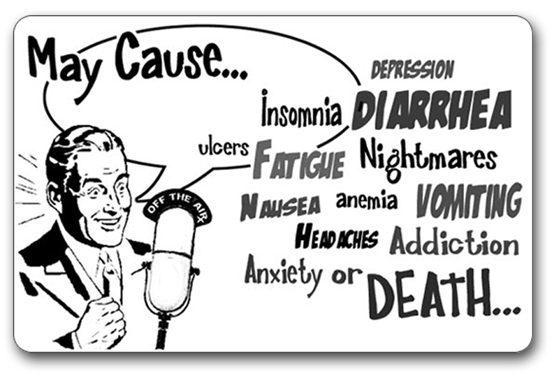Who doesn’t laugh at drug commercials with their before-and-after scenes of life-changing improvements accompanied by numerous terrifying side effects? But these drug ads continue because they work. Beyond the overt manipulations, there are more covert ones—including techniques that diminish the impact of the required warning section.
Former advertising executive Jerry Mander observed that his ex-colleagues in advertising don’t care if you think their commercial is ridiculous or even false, because the image of the product goes into your head anyway, and your insides will always carry this “neuronal billboard.” Mander, in his 1978 book Four Arguments for the Elimination of Television, instructed us that TV commercials must be viewed with what he called “sensory cynicism.”
Nearly two decades after Mander’s book was published, a new kind of TV commercial—one requiring a different level of sensory cynicism—appeared in the United States. In 1997, the Food and Drug Administration implemented new rules for direct-to-consumer advertising for prescription drugs. These new rules required that the ad need only mention the major risks and prevalent adverse effects, provide a toll-free number, refer to other information sources, and state the need to see a medical professional. Those new rules made it possible to run a TV drug ad.
The task for drug advertisers was how to meet the requirement of stating major risks and prevalent adverse effects in a manner so that viewers do not care about them, ensuring the warning section will not interfere with the placement in viewers’ minds of those billboards of life-changing improvements.
While the FDA has scolded drug companies for using blatant techniques to distract viewers away from the warning section, STAT (“How Drug Ad Narrators Take the Scariness Out of Side Effects”) notes, “The FDA can’t do much about ads that bore consumers into ignoring the side effect lists.” Health and medicine publication STAT details how “the warning section may be written with more complex sentence structures, to make it harder for viewers to absorb.” STAT quoted Ruth Day, a cognitive scientist at Duke University who has studied drug ads: “There’s a shift in how the voice is used to make it easier to understand the benefits and less easy to understand the risks.” So, for example, a hurried warning narration makes it much harder to remember the warning section.
The rest of the Alternet story is here:
https://www.alternet.org/drugs/why-tv-drug-ads-work-despite-disclosing-terrifying-side-effects
